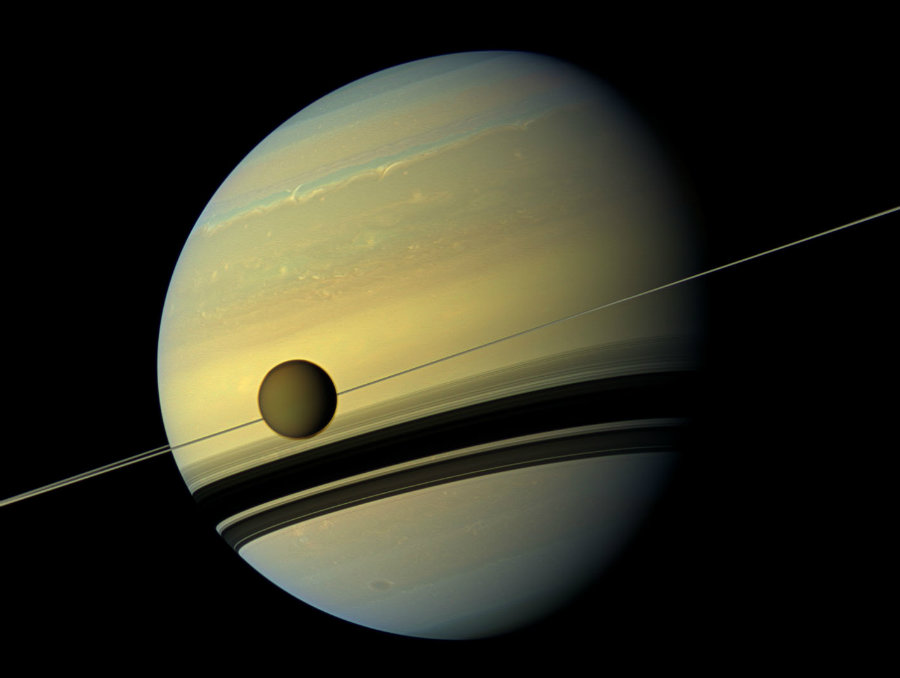The National Aeronautics and Space Administration (NASA) has identified the highest point on Titan, the largest moon of Saturn, which measures 10,948 feet (3,337 meters) at its highest peak. Results were obtained by Cassini’s mission and will be presented on Saturday at the 47th annual Lunar and Planetary Science Conference at The Woodlands in Texas.
The Titan’s tallest peak was found among a trio of mountainous ridges called the Mithrim Montes, said the NASA in a press release published Thursday. Moreover, researchers found that all highest peaks have at least 10,000 feet in elevation (3,000 meters).

According to Stephen Wall, deputy lead of the Cassini radar team at NASA’s Jet Propulsion Laboratory in Pasadena, California, the Mithrim Montes present the highest points that researchers have ever found on Titan, and it is highly possible that the record will not be broken in the future.
Results were obtained by analyzing data taken by the Cassini’s radar instrument. NASA researchers have explained that most of the tallest mountains found in Saturn are close to the equator. Moreover, they have found several similarities between mountains and cliffs located on Earth and Saturn.
NASA has explained that mountain formations on Earth are usually located in places where forces such as wind and rain, shape the mountain’s surface upward from underneath. The Himalayas and the Andes are great examples to demonstrate that, adds the space agency.
It appears that Titan’s surface has also been eroded by rain and rivers. However, the process takes longer on Saturn when comparing it to Earth, since our planet is 10 times closer to the Sun.
Titan’s tall peaks on an icy ocean world remain a mystery
It is recognized that Titan has an icy crust that covers a deep ocean of liquid water. That being said, scientists were not expecting to find huge mountains in it. A theory suggests that mountain formations in Titan could demonstrate that tectonic forces could be affecting the surface.
“As explorers, we’re motivated to find the highest or deepest places, partly because it’s exciting. But Titan’s extremes also tell us important things about forces affecting its evolution,” said Jani Radebaugh, a Cassini radar team associate at Brigham Young University in Provo, Utah, who led the research.
NASA will conduct new investigations to determine what exactly allows the formation of tall peaks (up to 10,948 feet in elevation), in the icy ocean world located in Titan, the fascinating moon of Saturn.
Source: NASA Press Release

Several of the facts in this story are incorrect, and do not reflect what the NASA news release or the current science suggests. And other items like writing “Saturn” instead of “Titan” creates confusion. As an example, “Results were obtained by analyzing data taken by the Cassini’s radar instrument. NASA researchers have explained that most of the tallest mountains found in Saturn are close to the equator. Moreover, they have found several similarities between mountains and cliffs located on Earth and Saturn.” There are no mountains on Saturn–it’s a gas giant.
Other sentences like this one demonstrate a lack of understanding for basic geology, and do not represent what NASA’s news release said. You say, “NASA has explained that mountain formations on Earth are usually located in places where forces such as wind and rain, shape the mountain’s surface upward from underneath. The Himalayas and the Andes are great examples to demonstrate that, adds the space agency.” Wind and rain erode mountains from the top down–which is what NASA’s release said.
In any case, please have someone proofread and edit before you post! No one is perfect, but there are glaring errors here that discredit your site!
That was my impression too, that this article was a Hodge podge of almost incoherent misinformation. Plate tectonics creates large mountains, not wind.
And who knows what the core of Saturn looks like it is a huge gas giant impenetrable to radar – yes they probably mean Saturn’s moon, or Titan instead of Saturn.
That was my impression too, that this article was a Hodge podge of almost incoherent misinformation. Plate tectonics creates large mountains, not wind.
And who knows what the core of Saturn looks like it is a huge gas giant impenetrable to radar – yes they probably mean Saturn’s moon, or Titan instead of Saturn.
That was my impression too, that this article was a Hodge podge of almost incoherent misinformation. Plate tectonics creates large mountains, not wind.
And who knows what the core of Saturn looks like it is a huge gas giant impenetrable to radar – yes they probably mean Saturn’s moon, or Titan instead of Saturn.